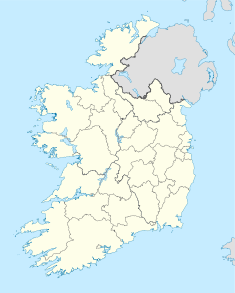- O'Dea Castle
-
O'Dea Castle O'Dea CastleLocation: 3 miles (5 km) South of Corofin, County Clare, Ireland Coordinates: 52°54′41″N 9°3′59″W / 52.91139°N 9.06639°WCoordinates: 52°54′41″N 9°3′59″W / 52.91139°N 9.06639°W Built: late 15th century O'Dea Castle is an Irish fortified tower house, loosely described as a castle, [A] at Dysert O'Dea (Irish: Dísert, meaning "hermitage"), the former O'Dea clan stronghold, 5 km from Corofin, County Clare just off the R476 road.[1]
It was built between 1470 and 1490 by Diarmaid O'Dea, Lord of Cineal Fearmaic, and stands some 50 feet high on a limestone outcrop base measuring 20 feet by 40 feet. [2]
Contents
Clare Archaeology Centre
The castle is home to the Clare Archaeology Centre, with exhibits of area archaeological artefacts from 1000 BC to 1700 AD, local history over the last three centuries, and a wall walk of parts of the castle.
The Dysert O’Dea Archeology Trail includes sites around the castle, including the remains of the Dysert O'Dea Monastery.
History
The Battle of Dysert O'Dea, which drove the Anglo-Normans from the region for over 200 years, took place at this site on 10 May 1318.
In 1968, John B. O'Day of Wisconsin Rapids, WI, USA, while touring Ireland, discovered Dysert O'Dea Castle was for sale. He also knew that he was a direct descendant of the builder. Between 1971 and 1983, he purchased and commenced with repairs to protect what remained of the castle. Dysert O'Dea has become one of the most visited sites in Clare and continues to be a site of valuable archaeological investigation. It has also won the "Clare Tourism Award" for being one of the most authentically rebuilt castles in Ireland.
Site description from Irish Tourist Board:Dysert O'Dea Castle and Archaeological Centre in Corofin is known for its wealth of historical and archaeological remains. Built in 1480 the castle is now an archaeological centre with more than twenty five archaeological and historical sites. Notable aspects are the 15th century Dysert O'Dea Castle itself, two stone forts used during battles between local noblemen in the 16th century and the Saint Tola's High Cross, which dates from the 12th century. There is also an example of a fulacht fiadh, or ancient cooking site. An archaeological trail has been developed to highlight 25 of the field monuments within a 6km radius of the Castle, the most famous of which include a Romanesque Doorway (dating from the 12th century) and High Cross.Pictures
See also
- Tower houses in Britain and Ireland
- O'Dea clan
- Dysert O'Dea Monastery
- Battle of Dysert O'Dea
External links
- Clare Archaeology Centre - official site
- O'Dea Clan Site
- O'Dea Castle entry in Placenames Database of Ireland
Further reading
- O'Dea: Ua Deághaidh: The Story of a Rebel Clan, by Risteárd Ua Cróinín (Richard Cronin), Ballinakella Press, Whitegate, Co. Clare, Ireland, 1992. ISBN 0946538077.
- Irish Battles - A Military History of Ireland, by G.A. Hayes-McCoy, Appletree Press, 1990, ISBN 086281250X
Notes
- ^ Ua Croinin and Breen comment in The Other Clare, 1985: "The castle itself is more correctly designated a tower-house as it falls easily in the category of such fortified houses built in great numbers throughout the southern part of Ireland between 1400 and 1600." [2]
References
- ^ Caisleán Uí Dheá Placenames Database of Ireland. Retrieved: 2011-11-22.
- ^ a b Dysart O'Dea Castle, Co. Clare by Risteard Ua Croinin and Martin Breen, The Other Clare, Volume 9, page 17. Shannon Archaeological and Historical Society, April 1985.
Categories:- Castles in County Clare
- Historic house museums in the Republic of Ireland
- Museums in County Clare
- Archaeology museums in the Republic of Ireland
Wikimedia Foundation. 2010.








